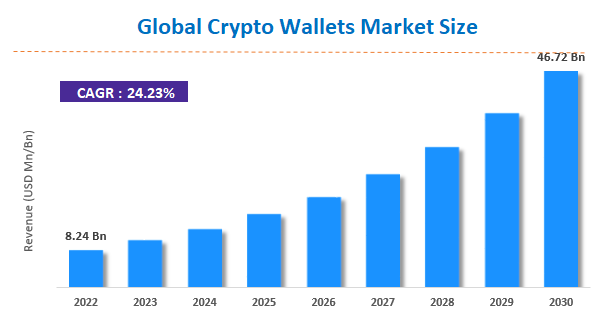
As the digital asset sector has continued to evolve and grow over the last few years, there has been an undeniable rise in the number of users who have entered this burgeoning fray. To this point, a recent report suggests that global crypto ownership rates have been growing at an average rate of 4.2% per annum, with there being more than 420 million crypto users worldwide at the moment.
In the midst of this adoption surge, cryptocurrency wallets have continued to play a pivotal role within the ecosystem, and rightly so. For starters, they serve as personal ledgers for users to manage their holdings securely, however, their use cases can be manifold — extending well beyond the realm of asset storage alone.
Crypto wallets can be categorized into two types, hardware and software wallets. In essence, hardware wallets are physical devices that store users’ private keys offline, ensuring an isolated environment away from internet vulnerabilities. On the other hand, software wallets are digital applications that provide a user-friendly interface and immediate access to one’s assets, thus making them extremely suitable for active traders and daily transactions.
From a financial perspective, the digital asset wallet market — worth $8.24 billion in 2022 — is set to grow to a projected valuation of $46.72 billion by 2030, expanding at a CAGR of roughly 24.23% over the above-mentioned time period.

Navigating the Crypto Landscape With User-friendly Wallets
In order to grow the web3 userbase, new users need to be invited and educated by existing web3 user, but many of the options available today come with a steep learning curve — hurdles such as deciding between hundreds of wallets, understanding private keys, backing them up, and onramping from an exchange to load the wallet with crypto to start transacting, this deters individuals from venturing into web3 entirely.
However, the crypto community has recognized this barrier and has been actively facilitating the development of innovations aimed at simplifying the experience of users operating in this space.
In fact, a report by UK-based fintech consultancy group Penser states that one of the five key barriers preventing many individuals from harnessing the power of crypto tech is the lack of simple storage solutions, noting:
“The need for multiple wallets is a much-needed security feature, but the user experience is far from friendly. If users are forced to remember multiple digits to log into their wallets every time they want to transact with their crypto assets, the tedious user experience makes it less likely for the general public to choose crypto payments…. The process to buy, sell, and store crypto assets also needs to be reworked to make it much more user-friendly.”
To address these bottlenecks, the market has recently seen the advent of various high-quality wallet solutions that are not only easy to use but offer a high degree of operability. SendIt, by Arcana Network, is a prime example of this. Since its market debut — which was a little over 60 days ago — the product has amassed over 500,000 users and processed 2.3 million+ transactions.
SendIt is tailored sending crypto to anyone in the most seamless manner possible, allowing users to transfer digital assets to anyone via email or Twitter even if the recipient is new to web3 and doesn’t to own a crypto wallet. This feature drastically lowers the entry barrier, inviting more individuals to explore the crypto ecosystem.
Technically speaking, upon initiating a transaction, a shareable link is generated for the recipient, who can then access the funds through the link using their email for authentication.
The fear of erroneous wallet addresses, a common concern among crypto novices, is alleviated as transactions only require familiar identifiers like email addresses.
Simply put, SendIt provides users with an embedded, non-custodial, and secure wallet through an email ID, that is ideal for new market entrants.
Looking ahead
With the Web3 sector anticipated to grow immensely over the coming decade — as highlighted by the meteoric rise of developer activity within the market — there is no denying that crypto wallets will continue to play an indispensable role within this rapidly evolving ecosystem.
For example, the decentralized application (dApp) domain has witnessed a remarkable increase in daily unique active wallets (dUAW) since 2021, with this metric rising to a whopping 1,967,051 addresses during May 2023. Not only that, a 50% growth in active wallet numbers between 2021 and 2022 was also recently recorded, reflecting a growing user base within this niche market.
Thus, as we move toward an increasingly decentralized future, the recent proliferation of user-friendly wallets like SendIt stands to lay the foundation for a more inclusive digital asset ecosystem. SendIt’s innovative approach — which addresses common fears and complexities associated with crypto transactions — , can encourage users to engage with the various apps in the ecosystem, contributing to the broader acceptance of crypto in the process. Thus, moving ahead, it will be interesting to observe how this space continues to evolve and grow.









